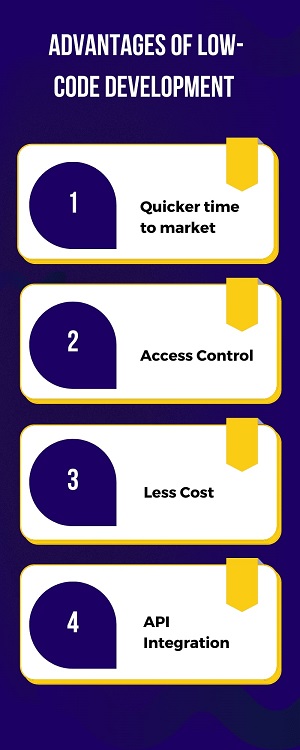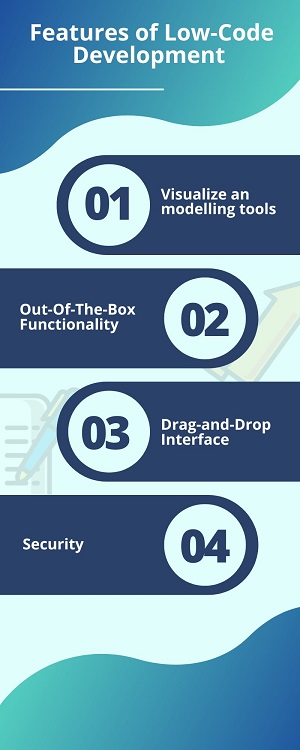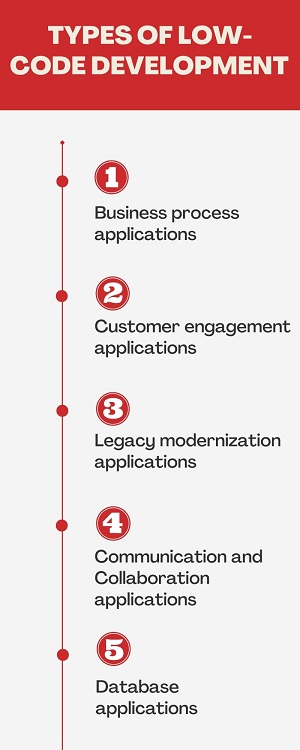
Everything to know about Low code development
Low code development solutions are an exciting way to create and develop applications. But what is low code development, and how does it work? Why select this development to make your next application?
In this post, you will learn about low code development, what is being made with it, and how it will be useful in your mobile app development.
What is low code?
Low code is the software development perspective that needs little to no coding to create processes and apps. Rather than using programming languages, you can apply the visual interfaces with basic logic and drag-and-drop capabilities in the low-code development platforms. As they are fast and simple alternatives to conventional software development, these platforms have grown in popularity quickly.
What is low code development?
Low code platforms offer developers a flexible and visual environment to build simple to complicated applications in the graphical interface. The help of advanced tools like drag-and-drop modellers, intuitive UI, etc., allows programmers to design and deploy the apps much quicker and allows the organizations to scale and get the maximum profit from low-code development platforms.
Instead of using hand-coded computer programming, a low-code development framework provides the programming environment for developing the software applications via the graphical user interface and configuration.
Low-code creation frameworks allow IT customers to incorporate the building blocks into the applications and workflows. These primary elements abstract away code behind actions and orders, allowing an IT to make interfaces and business applications without coding them by hand.
Who are the low-code developers?
Users with no advanced software development or coding knowledge may utilize these innovative techniques to create custom software development for multiple purposes, developing business and enterprise mobile applications. App developers use the low-code framework to create applications of a wide variety to fulfil any market demands for growth, simplify a procedure, and provide the facility for digital transformation.
What will be the low-code development market in the year 2023?
The low code development platform market size is about to reach USD 148.5 billion by 2030, which will grow at a CAGR of 27.8% during the forecast period (2022-2030). North America has accounted for the largest market share during the forecast period.
What are the pros of a Low-Code development platform?
Low-code integration will quickly provide observable results for the business. Here are some of the most important benefits of using the low-code development platform.

1. Quicker time to market
Building a custom-built application or a smartphone app is a dynamic process and is time-consuming. On the other hand, the low-code development platform will greatly shorten the production time.
2. Access Control
Business users conveniently grant access to their program by using the low-code platform. Users can monitor who will access the application on the broad and micro levels. An application creator may assign users as administrators, end-users, or co-owners.
3. Less cost
Conventionally creating a software application and coding manually for each part of a system is very complicated, needs a lot of time, and requires a high budget. However, a low-code platform allows the development of applications in very less time, lowering the process’s cost.
4. API Integration
A low-code platform gives users the graphical interface and drag-and-drop functionalities to rapidly build applications without writing thousands of lines of code. The low code platform will provide seamless integration with various APIs by accelerating the application development step-by-step guidance, making it easier to add new feature updates to the functionalities of the applications.
What are the functionalities of a low-code development platform?

1. Visualize an modelling tools
It will take less time to build the application using visual approaches and templates to develop the apps using the code. Low-code systems equipped with visual modelling features use the built-in modules to reflect any details in a way everyone can understand, from non-technical enterprise users to skilled developers.
2. Out-of-the-box functionality
OOTB (out-of-the-box) software is delivered by well-known low-code platforms that will remove any need to create key components for apps from scratch. However, some of the low code systems, For example, give the data storage or the customer-facing applications components, as well as service management or sales process management.
3. Drag-and-drop interface
Drag-and-drop functionality is available on any of the leading low-code platforms. It provides the critical and valuable functionalities that facilitate a production procedure. The drag-and-drop features offer app support throughout development to the coders.
4. Security
Low-code tools only give a good solution, no matter how user-friendly. Before using a low-code development framework, ensure that it provides enough protection to secure an app, whether you are creating the platform as a whole.
How many types of low-code development platforms?

1. Business process applications
These platforms enable businesses to make the apps that run and manage and daily operations of the enterprise. These apps streamline workflows, automate repetitive tasks, and enhance operational efficiency. They are generally known as low-code BPM.
2. Customer engagement applications
It helps to create an omnichannel customer-related application that will quickly address and manage many customer problems. Organizations can develop apps for customer acquisition, retention, and engagement and will give high-quality and personalized deliverables.
3. Legacy modernization applications
These platforms will modernize, digitize or hugely revamp the legacy systems. However, a legacy system usually slows down the digital growth of an application. Many enterprises’ mobile app development uses low-code platforms to create modern, flexible, and high customize applications to boost the business and meet the growing market demand.
4. Communication and collaboration applications
Low-code platforms aid you in designing and creating apps by enabling seamless collaboration and communication between development teams. Employees can easily share the content, assign tasks and accelerate the approvals from a single codebase. These applications focus on creating a collaborative culture by enabling the easy flow of data and boosting productivity.
5. Database applications
Businesses create apps to upload, retrieve and manage a large amount of data. Many branches and departments in the organization deal with extensive data daily. With low-code platforms database, applications are easily built to collect and streamline the data without taking much time.
What is the difference between a low code and no code?
Low code
- People with minimum coding experience will use a low-code approach to create and launch the applications.
- It increases productivity by streamlining an app development process
- It reduces the cost because an app is built in-house and has the minimum coding
- Uses the visual building tools, which may need a minimal backend code
- Businesses can maintain flexibility with app customization and updates.
No Code
- People with zero coding skills will utilize no-code development to create and launch the apps.
- It has raised productivity by streamlining app development.
- Reduce the costs since it makes the app in-house along with zero coding.
- It makes use of visual building tools that require zero backend code.
- Develop and launch applications quickly and will be easily released in the market for the users to use their app services.
What are the principles of low-code development?
The principles of low code will determine the standards platforms must follow to give convenience to their users.
1. Model-driven development:
It provides business value to users with automation, flexibility, data security, and customization.
2. Collaboration:
The platform must make the visual language business owners and programmers use to improve collaboration via information exchange.
3. Agility:
The low-code platform should lessen development complexity to improvise efficiency, accelerate final delivery, and will give great business value.
4. Cloud:
Cloud must simplify, develop and accelerate the project deployment to meet consumer demands.
5. Openness:
This platform enables the making of various categories of software. It is an all-in-one solution for better and rapid application development.
6. Multi-User development:
The platform must have the compatibility of multi-user and project synchronization for several projects. The developers can work on similar projects simultaneously because of low-code development platforms.
7. Innovation and Experimentation:
The low-code development platform services will give a fair price to many business owners to transform their ideas into reality. It will also help the developers do experiments with the project and provide the final results, representing the best of the apps.
8. Governance and Control:
The platform must have a standard and reliable standard to give a great user experience. The owner must take control of any suspicious activity before it becomes the primary security problem.
9. Community:
The platform must permit the creation of a community to promote its reliability, flexibility, and authenticity.
What are the steps to create a low-code application platform?

1. Model the process
The processes are powering applications that deliver real business value. Hence, the first step in app development is to model processes in line with business needs. The drag-and-drop interface will help you create the procedure diagram to define a process flow in the application so that each activity performs correctly to get the desired output. You can also find the most efficient path and use the process of mining to learn from the data, which will unlock new insights.
2. Model the data
Data is a valuable business asset, and collecting the right data is the key to our application running as it should. Define the steps in your process and follow the order to determine the needed data at each stage. The wizard will help you design the data model that sorts out the required information for various activities. The low-code approach creation of your entities, relationships, and attributes that is completed without writing a single line of coding.
3. Define Forms
It engages an application that relies on a good user experience. It allows you to connect with the process diagram and the data structure that will design an user interface and select what information will be collected from and displayed to the users while using the application.
4. Enter business rules
Once you know what type of data is input and how it’s being displayed, the next stage will define the details of the process in terms of the logic. Although, The method of logic like data validation, automatic pre-load of data, and control of the errors, among others, in the app development. However, multiple wizards can create any logic easily.
5. Set performers
You hire the developers because they have the correct skillset to do this job. Bosc Tech Labs allows you to identify which users are needed to do the tasks at various stages in the procedure depending on the skills and factors such as location, language, and workload. It ensures you do things with the right people at the perfect time.
6. Integrate with other systems
At this phase, your app is ready to go. But you are required to configure it with another external system, and processes will significantly impact business. The data source lets you view multiple systems and applications across an enterprise, ensuring your operations run smoothly.
7. Execute and Test
In the last stage, a wizard helps you deploy your project to test environments so you can carry out user acceptance testing and make the changes based on feedback from end users. Once all your stakeholders are happy with an application, your app is ready to go live.
Conclusion
Low-code development has found a niche in the market, and its popularity will constantly grow. It is the best and most amazing choice for enterprises who want to speed up their digital transformation and automates business processes.
Let’s get in touch with us, and we will be happy to help you!
Frequently Asked Questions (FAQs)
1. What issue does low code resolve?
Low code development helps the developers to reduce their dependencies on the programmers, and due to this, businesses can generate and launch new mobile applications in a short time.
2. What is the future of low code?
Low code tools must easily promote collaboration between developers and non-developers. This platform will provide relatively easy and secure ways for experts to access code to modify and extend it as much as possible.
3. Why do we require low codes?
Low-code platforms will give visual editors and reusable actions that users can drag and drop into the processes for rapid development. Low-code development platform enables the IT to rapidly assemble new methods and build the application without researching, writing, and testing the new scripts.
Book your appointment now